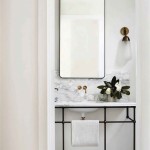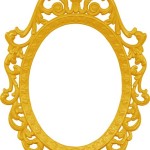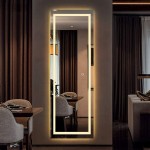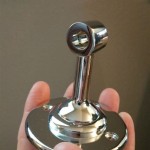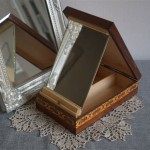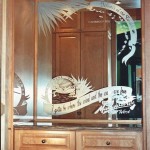Understanding the Utility and Application of Mirror Hanging Strips
Mirror hanging strips represent a specific type of adhesive product engineered to securely mount mirrors onto various surfaces without the need for traditional hardware like nails or screws. These strips are typically double-sided, with one side adhering to the back of the mirror and the other to the wall. The composition of these strips usually involves a high-tack adhesive combined with a carrier material designed to distribute weight and resist slippage. Understanding their composition, weight capacity, and proper application is crucial for ensuring a safe and aesthetically pleasing installation.
The primary advantage of using mirror hanging strips lies in their ease of use and the minimal impact on the mounting surface. Unlike nails or screws, these strips do not create holes, thereby preserving the integrity of the wall. This is particularly beneficial for renters or individuals who wish to avoid causing permanent damage to walls. Furthermore, the installation process is generally quicker and requires fewer tools, making it a user-friendly option for DIY projects.
However, the effectiveness of mirror hanging strips is contingent upon several factors, including the weight and size of the mirror, the type of wall surface, and the quality of the adhesive. Therefore, a careful assessment of these factors is paramount before opting for this method of mirror installation. Overlooking these considerations can lead to the mirror detaching from the wall, potentially causing damage to the mirror itself, the surrounding area, or even posing a safety hazard.
Key Considerations Before Using Mirror Hanging Strips
Before committing to using mirror hanging strips, a thorough evaluation of several factors is necessary to ensure a successful and safe installation. This involves assessing the mirror's characteristics, the wall's properties, and the environmental conditions of the room where the mirror will be hung.
Firstly, the weight and dimensions of the mirror are critical. Mirror hanging strips are manufactured with specific weight capacities, which are typically indicated on the product packaging. Exceeding these limits can significantly increase the risk of the adhesive failing. It's prudent to choose strips that offer a weight capacity exceeding the actual weight of the mirror to provide a margin of safety. The size of the mirror is also important because larger mirrors exert greater leverage on the adhesive, potentially compromising its bond. For larger, heavier mirrors, alternative mounting methods may be more suitable.
Secondly, the type of wall surface plays a significant role in the adhesion process. Smooth, clean, and non-porous surfaces, such as painted drywall or tile, generally provide the best adhesion for mirror hanging strips. Textured walls, wallpaper, or surfaces with peeling paint can hinder the adhesive's ability to form a strong bond. In such cases, surface preparation is essential. This may involve sanding down rough areas, removing loose paint or wallpaper, and cleaning the surface with a suitable cleaning agent to remove dust, grease, and other contaminants. It is vital to consult the strip manufacturer’s instruction about what cleaner is suitable, as some cleaners might leave a residue that will ruin the adhesive strip's effectiveness.
Thirdly, environmental factors such as humidity and temperature can affect the performance of mirror hanging strips. High humidity levels can weaken the adhesive over time, while extreme temperature fluctuations can cause the adhesive to expand and contract, potentially leading to failure. It is advisable to avoid using mirror hanging strips in bathrooms or other areas with high humidity or significant temperature variations. If such environments are unavoidable, selecting strips specifically designed for moisture resistance is recommended.
Proper Installation Techniques for Mirror Hanging Strips
Even with the appropriate mirror hanging strips selected, proper installation is crucial for ensuring a secure and long-lasting bond. Rushing the installation process or neglecting to follow the manufacturer's instructions can significantly increase the risk of failure. A methodical and precise approach is essential.
The first step involves meticulously cleaning the back of the mirror and the wall surface. Any dust, grease, or other contaminants can impede the adhesion process. Use a clean, lint-free cloth and a suitable cleaning agent to thoroughly clean both surfaces. Ensure that both surfaces are completely dry before proceeding. Alcohol-based cleaners are often recommended for removing residue without leaving behind any film.
Next, carefully apply the mirror hanging strips to the back of the mirror. Follow the manufacturer's recommendations regarding the placement and spacing of the strips. Generally, strips should be distributed evenly across the back of the mirror, with emphasis on the corners and edges, where stress is concentrated. Apply firm pressure to each strip for the recommended duration, typically 30-60 seconds, to ensure a strong initial bond. Avoid touching the adhesive surface once the backing is removed.
After applying the strips to the mirror, carefully align the mirror with the desired location on the wall. Use a level to ensure that the mirror is straight. Once aligned, press the mirror firmly against the wall, applying even pressure across the entire surface. Hold the mirror in place for the recommended duration, typically several minutes, to allow the adhesive to bond to the wall. Some manufacturers may recommend using painter’s tape to further stabilise the mirror for a few hours while the adhesive completely cures. It is critical to consult the manufacturer’s instructions for recommended curing times.
Finally, avoid subjecting the mirror to any sudden shocks or vibrations during the curing process. This can weaken the bond and increase the risk of failure. Allow the adhesive to fully cure before cleaning the mirror or applying any additional weight. Regularly inspect the mirror and the surrounding area for any signs of loosening or shifting. If any issues are detected, take immediate corrective action to prevent the mirror from falling.
Understanding Adhesive Properties and Strip Selection
The effectiveness of mirror hanging strips largely hinges on the properties of the adhesive used. Different types of adhesives offer varying levels of strength, durability, and resistance to environmental factors. Understanding these properties is essential for selecting the appropriate strips for a specific application.
Acrylic adhesives are commonly used in mirror hanging strips due to their strong initial tack and good long-term adhesion. They offer good resistance to UV light and aging, making them suitable for indoor applications. Acrylic adhesives are also relatively resistant to moisture, although they may not be ideal for high-humidity environments. One consideration is the acrylic adhesives sometimes don’t work well with plastic surfaces because they do not adhere correctly to it due to chemical incompatibilities.
Rubber-based adhesives, on the other hand, offer excellent immediate adhesion and flexibility. They are particularly well-suited for bonding to uneven or textured surfaces. However, rubber-based adhesives may be more susceptible to degradation from UV light and high temperatures, making them less durable for long-term use in direct sunlight or warm environments. Rubber adhesive has a strong initial tack and is known for its immediate bonding strength. However, they can sometimes leave a residue upon removal, and may experience adhesive weakening where temperatures are high.
In addition to the type of adhesive, the thickness and composition of the carrier material also play a role in the performance of mirror hanging strips. Thicker strips generally offer greater weight capacity and better shock absorption. The carrier material, which is typically foam or film, helps to distribute the stress evenly across the adhesive surface, reducing the risk of localized failure.
When selecting mirror hanging strips, it is crucial to carefully read the product specifications and choose strips that are specifically designed for mirror installation. Avoid using generic adhesive tapes or strips that are not intended for this purpose, as they may not provide sufficient strength or durability. Look for strips that are labeled as "mirror hanging strips" and that have been tested and certified to meet industry standards.
Furthermore, it is advisable to purchase mirror hanging strips from reputable manufacturers who offer warranties or guarantees on their products. This provides assurance that the strips are of high quality and that the manufacturer stands behind their performance. It is also a good practice to consult with a professional installer or hardware store employee for advice on selecting the appropriate strips for a specific mirror and wall surface.

Using Command Strips For Hanging A Mirror The Morris Mansion

Using Command Strips For Hanging A Mirror The Morris Mansion

Using Command Strips For Hanging A Mirror The Morris Mansion

How To Hang Heavy Mirrors Frames Without Nails 3m

Command Mirror Organizer White Target

3m Command Large White Picture Hanging Adhesive Strip Holds 7 2kg Pack Of 4 Diy At B Q

Using Command Strips For Hanging A Mirror The Morris Mansion

Command 20 Lbs Black Picture Hanging Strips 16 Pack Pairs Of 17217blk 8es The Home Depot

Command Picture Mirror Hanging Strips Narrow 1 4kg For Pictures Pack Of 4 Sets

Using Command Strips For Hanging A Mirror The Morris Mansion


